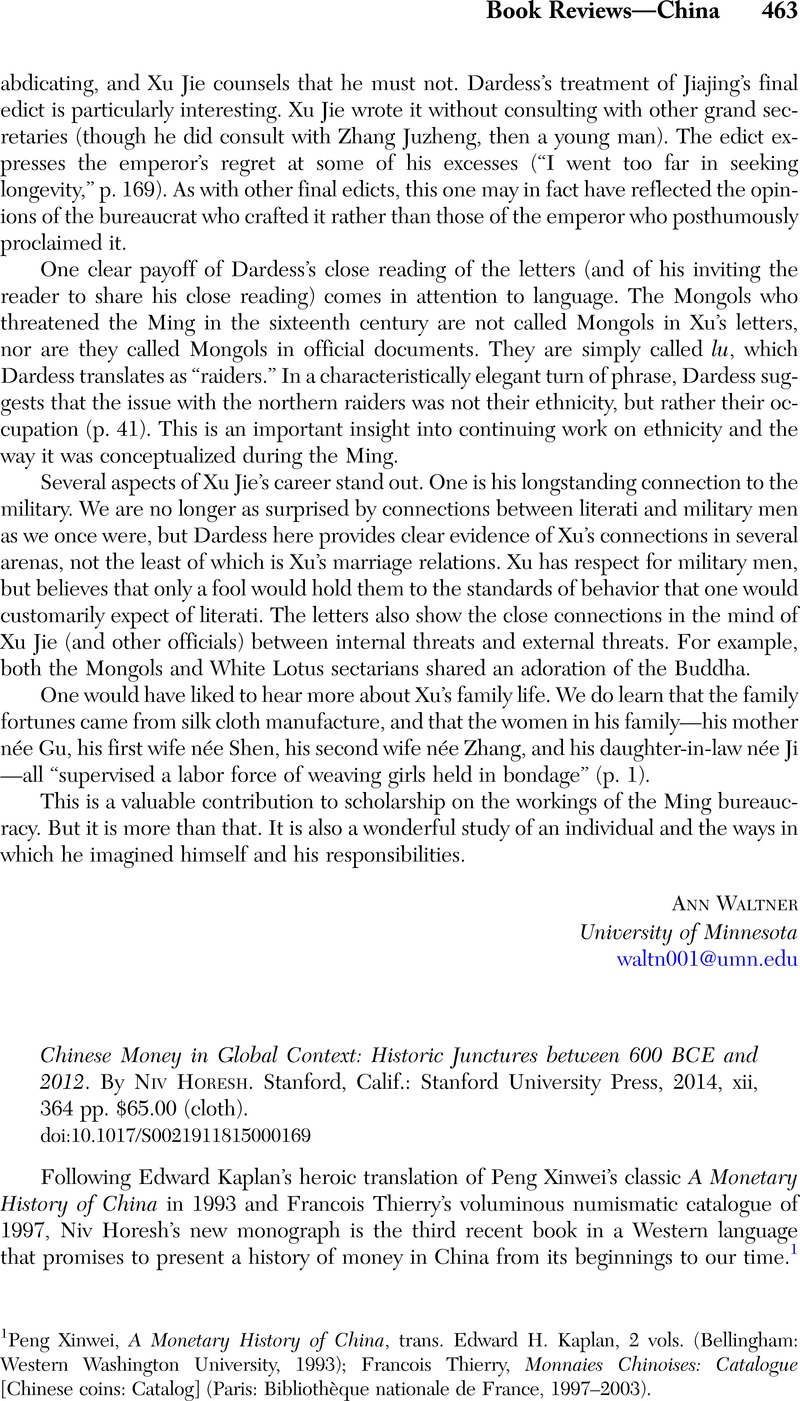No CrossRef data available.
Article contents
Chinese Money in Global Context: Historic Junctures between 600 BCE and 2012. By Niv Horesh. Stanford, Calif.: Stanford University Press, 2014, xii, 364 pp. $65.00 (cloth).
Published online by Cambridge University Press: 27 May 2015
Abstract

- Type
- Book Reviews—China
- Information
- Copyright
- Copyright © The Association for Asian Studies, Inc. 2015
References
1 Xinwei, Peng, A Monetary History of China, trans. Kaplan, Edward H., 2 vols. (Bellingham: Western Washington University, 1993)Google Scholar; Thierry, Francois, Monnaies Chinoises: Catalogue [Chinese coins: Catalog] (Paris: Bibliothèque nationale de France, 1997–2003).Google Scholar
2 For the debate, see Von Glahn, Richard, Fountain of Fortune: Money and Monetary Policy in China, 1000–1700 (Berkeley: University of California Press, 1996)Google Scholar; Frank, Andre Gunder, ReOrient: Global Economy in the Asian Age (Berkeley: University of California Press, 1998)Google Scholar; Man-houng, Lin, China Upside Down: Currency, Society, and Ideologies, 1808–1856 (Cambridge, Mass.: Harvard University Asia Center, 2006)Google Scholar; Irigoin, Alejandra, “The End of a Silver Era: The Consequences of the Breakdown of the Spanish Peso Standard in China and the United States, 1780s–1850s,” Journal of World History 20, no. 2 (June 2009): 207–44.CrossRefGoogle Scholar
3 For a Hayekian perspective, see Zhu Jiaming's recent two-volume compendium on China's monetary history: Jiaming, Zhu 朱嘉明, Cong Ziyou dao longduan: Zhongguo huobi jingji liangqiannian 從自由到壟斷: 中國貨幣經濟兩千年 [From laissez-faire to monopoly: The monetary economy of China—past and present] (Taipei: Yuanliu, 2012)Google Scholar. A less normative theory of concurrent and competing monies in history is being developed by Kuroda Akinobu and others; see the special issue of Financial History Review, 15, no. 1 (2008).Google Scholar
4 Horesh, Niv, Shanghai's Bund and Beyond: British Banks, Banknote Issuance, and Monetary Policy in China, 1842–1937 (New Haven, Conn.: Yale University Press, 2009).CrossRefGoogle Scholar
5 The debate, which was started by Milton Friedman, is summarized in Schiltz, Michael, The Money Doctors from Japan: Finance, Imperialism, and the Building of the Yen Bloc, 1895-1937 (Cambridge, Mass.: Harvard University Asia Center, 2012), 203–6CrossRefGoogle Scholar. For a positive assessment of the reforms, see Burdekin, Richard, China's Monetary Challenges: Past Experiences and Future Prospects (New York: Cambridge University Press, 2008), 95–117CrossRefGoogle Scholar; Shiroyama, Tomoko, China during the Great Depression: Market, State, and the World Economy, 1929-1937 (Cambridge, Mass.: Harvard University Press, 2008), 168–99.CrossRefGoogle Scholar
6 Akinobu, Kuroda, “The Eurasian Silver Century, 1276–1359: Commensurability and Multiplicity,” Journal of Global History 4, no. 2 (2009): 245–69.Google Scholar


